Luffa gourds are one of the most fascinating plants you can grow! They give you not only a sustainably sourced sponge but a delicious vegetable addition to your culinary creations!
If you’ve ever bought a luffa sponge from the store, you might be surprised to learn that they’re not a sea sponge, but actually grown on vines like a cucumber or squash. By growing your own, you’ll save money, eliminate packaging waste, and have complete control over how your sponges are produced. Plus, you’ll have access to tender young luffa as a unique addition to your garden harvest.
Are you ready to start your luffa journey? If you haven’t planted them yet, check out my complete guide to starting and growing luffa from seed: How to Grow Luffa in Your Garden – but if you’re ready to begin harvesting – this guide will walk you through everything you need to know about harvesting, processing, and using your homegrown luffa.
Here’s how to harvest, prepare, and use luffa gourds!
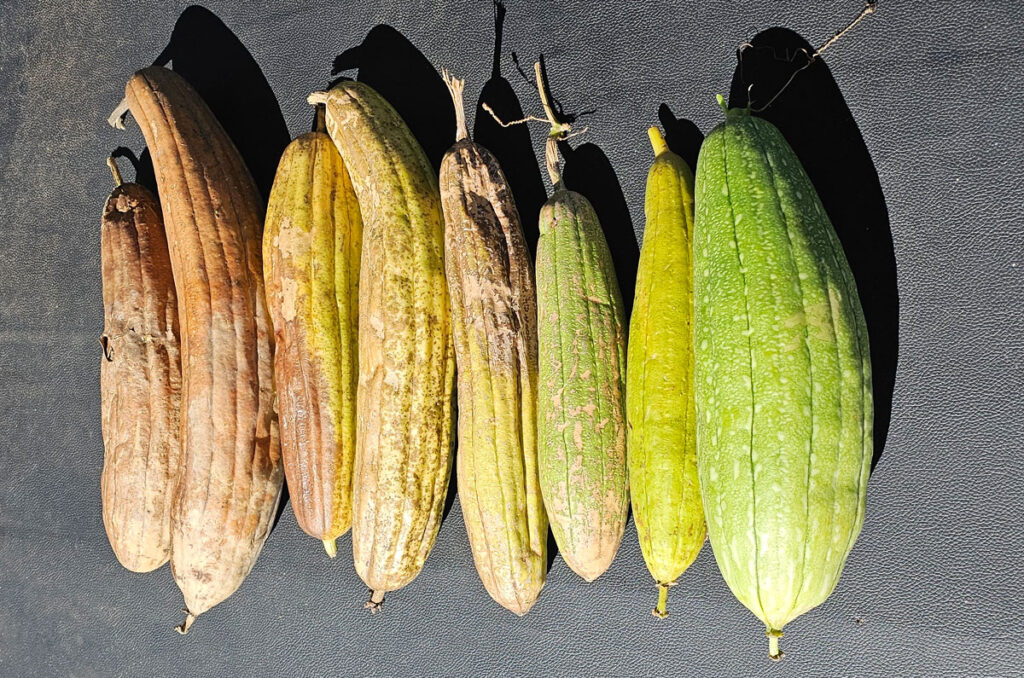
What You’ll Learn in This Guide
- Types of Luffa Gourds
- How to Harvest Luffa for Sponges
- Luffa Seed Saving Tips
- How to Harvest Luffa for Eating
- Luffa Recipes
- Using Luffa as Natural Sponges
- Using Luffa for Craft Projects
- Summary
- Resources
- FAQs
Types of Luffa Gourds
Before we dive into harvesting, it’s helpful to understand the two main types of luffa you might be growing: smooth luffa and ridged luffa.
Smooth Luffa
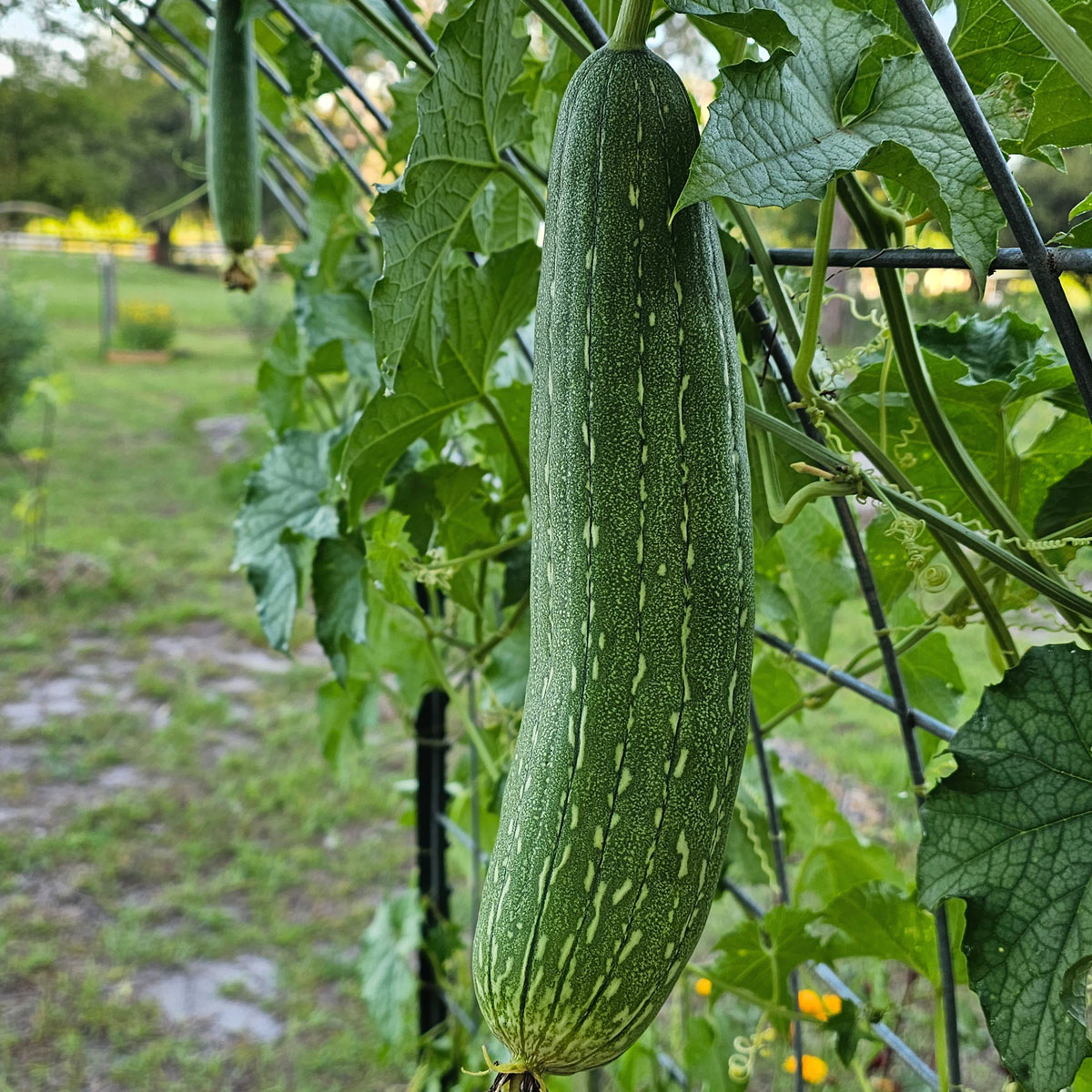
Smooth luffa (luffa aegyptiaca) is a luffa gourd with smooth skin. It is also known as Egyptian luffa or dishrag gourd and there are several varieties available to grow. It produces a long, smooth gourd that is ideal for sponges and can be eaten only when very young. Most varieties have seeds that are smooth and black with a distinctive groove along the edges, but there are also a few that produce white seeds with that same distinct edge. ¹
Ridged Luffa
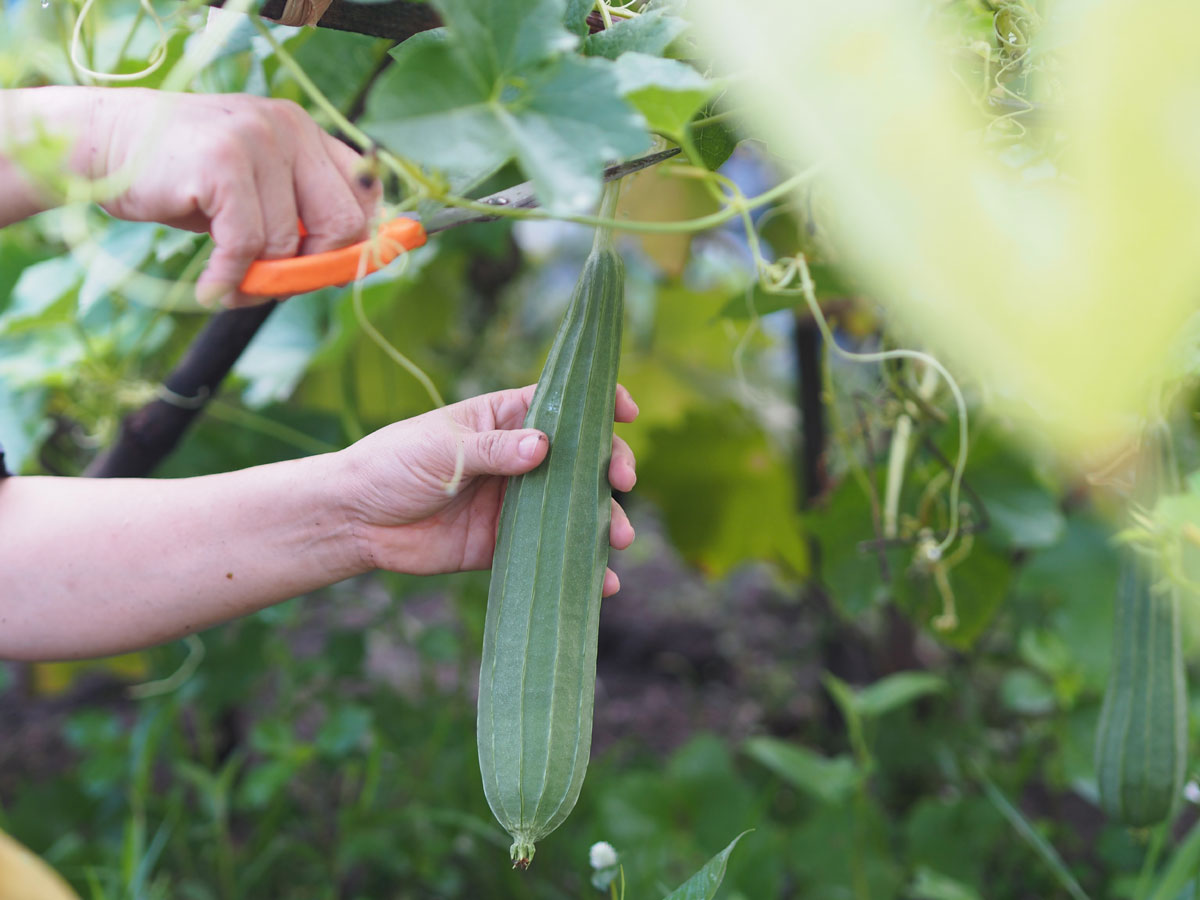
Ridged luffa (luffa acutangula) is also known as angled luffa, Chinese okra, or ridge gourd. This variety has distinctive ridges running lengthwise along the fruit. It’s primarily grown as an edible vegetable, especially in Asian cuisine, but it can also be used for sponges – though its fibers tend to be softer. The seeds are black with a pitted surface and lack the ridge seen on the smooth luffa. ²
While both varieties can serve either purpose, smooth luffa is generally grown for sponges, and ridged luffa is favored for its superior flavor and texture when harvested young.
How to Harvest Luffa for Using as a Sponge
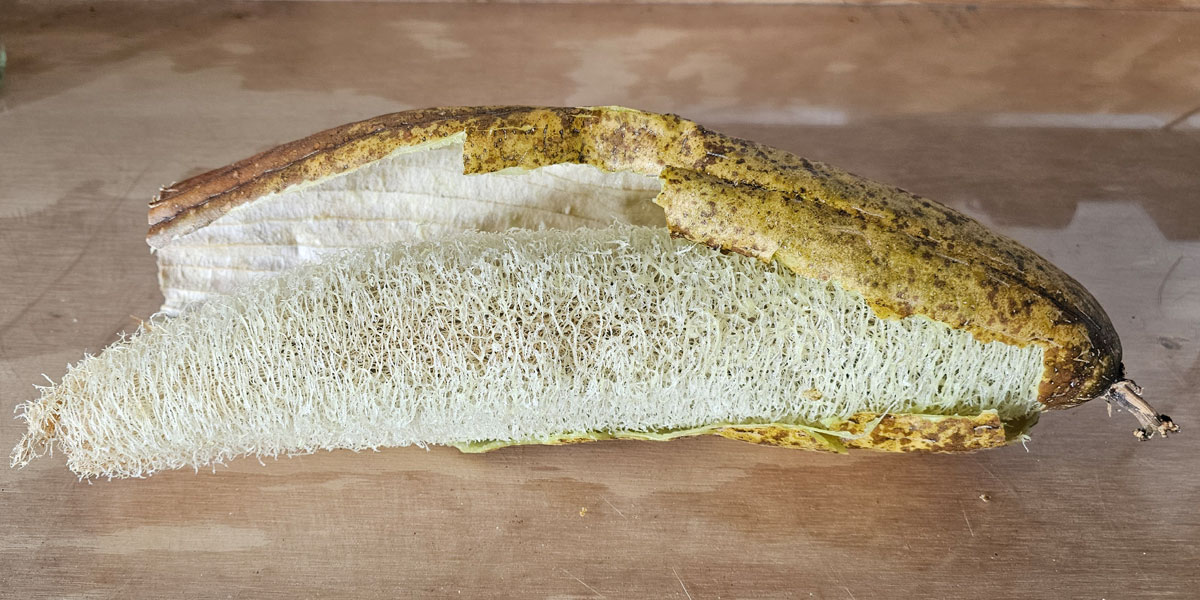
One of the most challenging decisions when growing luffa for sponges is deciding when to harvest. It requires patience and attention to detail to ensure you get beautiful, strong, and durable fibers. Harvest too soon, and you’ll get undeveloped fibers. Harvest too late, and you may find dark, possibly moldy sponges inside. Whether you prefer harvesting green, yellow, or brown luffas, here are the steps to ensure you get the best quality sponges.
Let the Gourds Fully Mature
The key to a good luffa sponge is allowing the gourd to mature completely on the vine. Harvesting when it’s fully dry gives you a natural, tan-colored sponge and ensures the seeds are fully developed. This is my favorite way to harvest luffa.
You’ll know it’s ready when the skin turns from green to yellow or brown, feels dry and brittle, and may start to crack or peel naturally. The gourd should feel lightweight with a hollow sound when tapped, and you’ll often hear the seeds rattling inside.
Harvesting Green for Softer Sponges
Some people prefer to harvest luffa while still green for a lighter-colored, softer sponge. The trick is to harvest a gourd that looks full-sized but is just starting to turn from green to yellow. It will feel heavier for its size, and you won’t hear seeds rattling inside. This method takes practice—sometimes you’ll peel one and find it hasn’t developed fibers yet.
Green luffas are also harder to peel since the skin is thicker, like peeling an orange. To make peeling easier, you can score the skin lengthwise with a sharp knife, then gently pull it back in strips. Soaking the green gourd in warm water for a few minutes can also help loosen the skin.
Once peeled, you’ll find the fibers are softer and less dense compared to fully matured luffa. The sponge may feel more flexible, making it great for gentle exfoliation or delicate household cleaning. However, because the fibers aren’t as tough, green-harvested luffas tend to wear out faster with regular use.
After peeling, rinse thoroughly to remove any pulp, using several rounds of fresh, clean water if needed. This helps wash away any lingering residue and ensures the sponge is fully clean. Then, allow it to air dry completely. Even though the fibers are softer, it’s still important to dry the sponge well to prevent mold or mildew from developing.
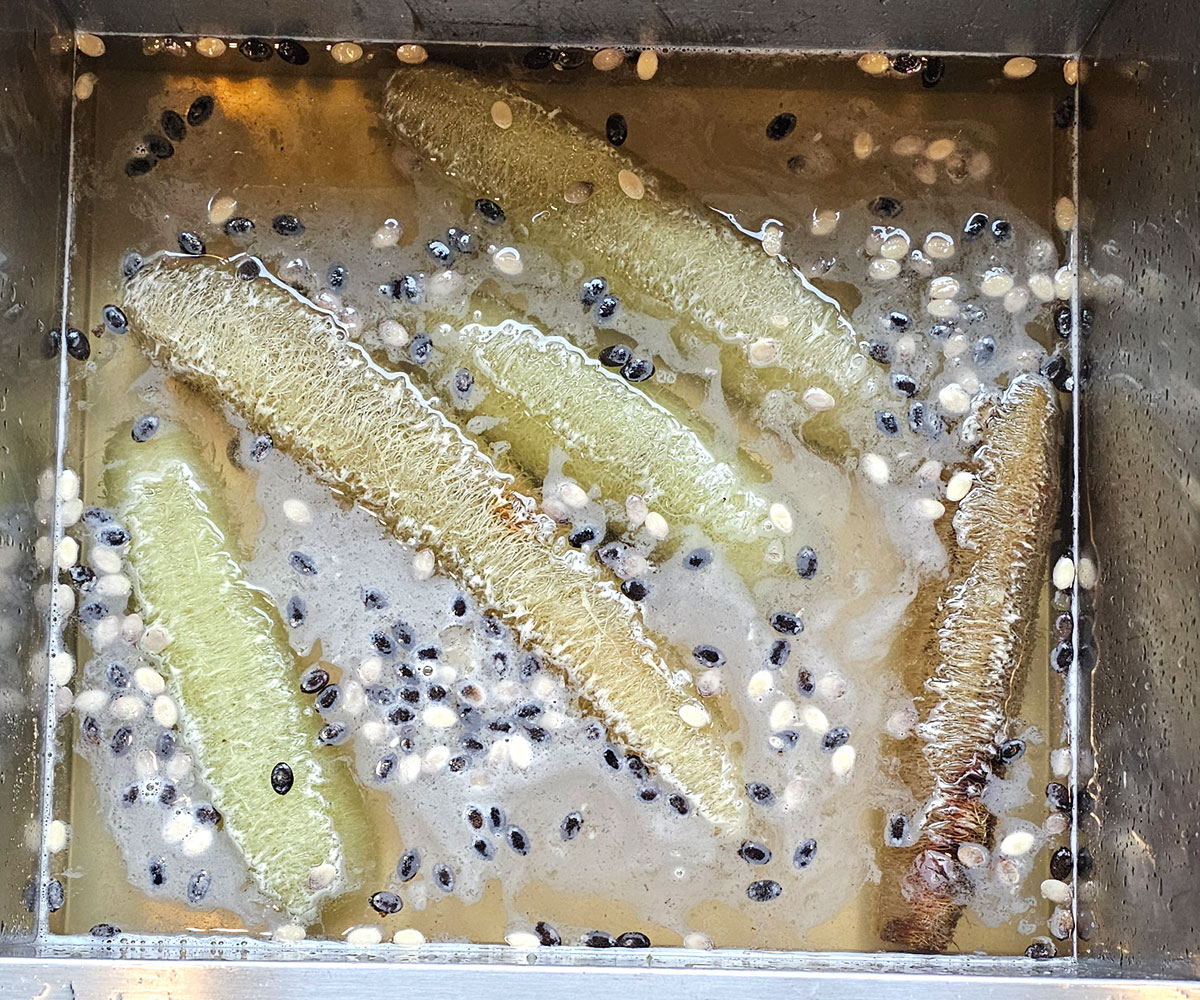
Watch for Signs of Mold as the Gourd Ripens
Mold can develop if the gourd doesn’t get enough sunlight and airflow, especially if it’s resting on the ground. Growing luffa on a trellis helps minimize this risk. If you spot mold, remove the gourd from the vine and let it continue to ripen in a sunny, well-ventilated spot. Don’t worry—mold-stained gourds can still be cleaned and used.
Monitor the Weather
Harvest before the first frost, as freezing temperatures can damage the fibers, making them slimy and prone to rot. Also, aim to pick them before long stretches of rain, which can cause rot on the vine or molding. If frost is imminent, harvest the gourds early and allow them to dry in a warm, sunny area like a south-facing window. I dry my unripened gourds in my garden shed near a sunny window.
Harvest with Care
Use sharp pruning shears or a knife to cut the luffa from the vine, leaving a small portion of the stem attached. This helps prevent moisture from entering the gourd through the cut end, reducing the risk of mold during drying.
Initial Drying (If needed)
If your luffa still has green patches or feels damp, let it finish drying in a warm, well-ventilated spot. A sunny area works great—I like to lay mine out on our picnic table under the gazebo, sometimes for a couple of weeks. This is especially useful if you have to harvest early before a frost but still have plenty of warm days left. Be sure to turn the gourds regularly to ensure even drying and prevent mold.
Peeling the Skin and Removing Seeds
Once the gourd is fully dry, the outer skin should be easy to crack and peel away. You can gently squeeze the gourd to help loosen the skin or tap it on a hard surface. My favorite method is cutting off each end and hitting the gourd inside a 5-gallon bucket. This won’t damage the tough fibers, and the seeds and crumbling skin fall right into the bucket. Shake out all the seeds—it might take a few minutes. Save the seeds in a cool, dark space for next season.
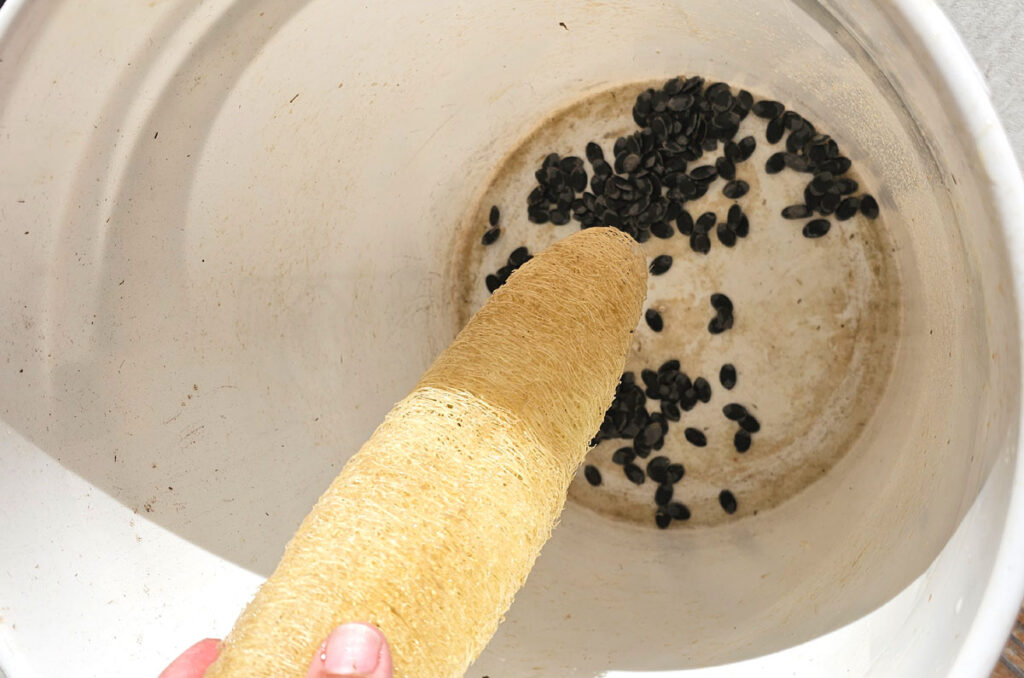
Cleaning the Fibers
After removing the skin and seeds, rinse the luffa thoroughly to wash away any remaining pulp. A bit of mild dish soap can help remove any stubborn residue. For tough spots, soak the luffa in warm water for about ten minutes to loosen any lingering bits. You may need to rinse it a few times in clean water to ensure the fibers are completely free of debris.
If you prefer a lighter-colored sponge, soak the cleaned luffa in a mild bleach solution (1 part bleach to 10 parts water) for a few minutes. This will brighten the fibers without weakening them. Be sure to rinse thoroughly afterward to remove any bleach residue.
Final Drying
Allow the cleaned luffa to air-dry completely in a sunny, well-ventilated area. Proper drying is key—any trapped moisture can lead to mold. I like to keep mine in a wicker basket in a room with good airflow, but any dry, breezy spot will do. Turn the luffas occasionally to ensure even drying.
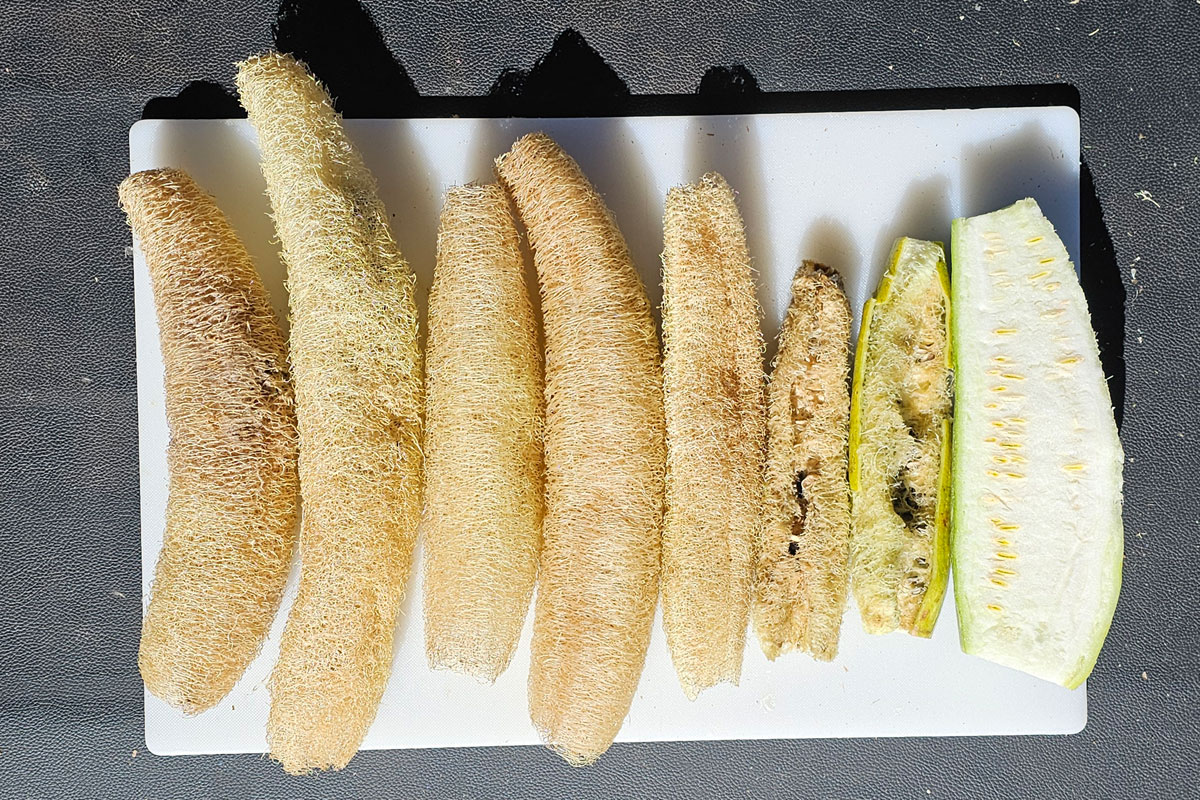
With the right care, you’ll have beautiful, durable luffa sponges ready for household cleaning, personal care, or even creative crafts.
Saving Luffa Seeds
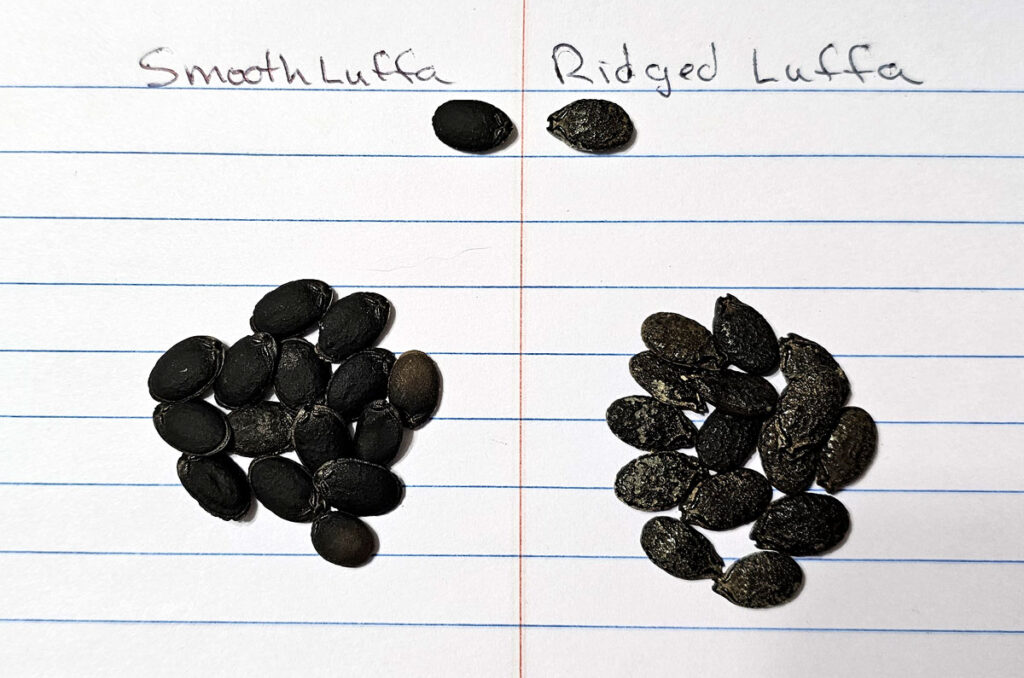
If you’ve grown healthy luffa plants, saving seeds for next season is simple and rewarding. Luffa seeds are abundant and easy to harvest, ensuring you’ll have plenty to plant or share. Seed saving also helps preserve the traits you love most in your plants, like vigorous growth, acclamation to your climate, or sponge texture.
Here are some tips for successful seed saving:
- Choose the Best Gourds: Select mature, healthy gourds for seed saving—ideally those that dried naturally on the vine. Seeds from well-developed gourds are more likely to be viable.
- Sort and Clean: After removing them from the gourd, sort out any debris, broken seeds, or discolored ones. Healthy seeds are hard, dark, and slightly glossy.
- Dry Thoroughly: After removing them from the gourd, spread them out in a single layer on a tray or paper towel in a warm, shaded spot for several days. Make sure the seeds are completely dry before storing
- Store Properly: Keep seeds in a cool, dry, dark place. Paper envelopes, glass jars, or small cloth bags work well. Label your seeds with the date and variety to keep track of their age.
- Check Viability: If stored properly, Luffa seeds can remain viable for several years. To check if they’re still good, perform a simple germination test by placing several seeds between damp paper towels and seeing how many sprout.
Saving your own seeds not only saves money but also strengthens your connection to your garden. Plus, you’ll always have a supply ready for future planting or sharing with fellow gardeners.
How to Harvest Luffa for Eating
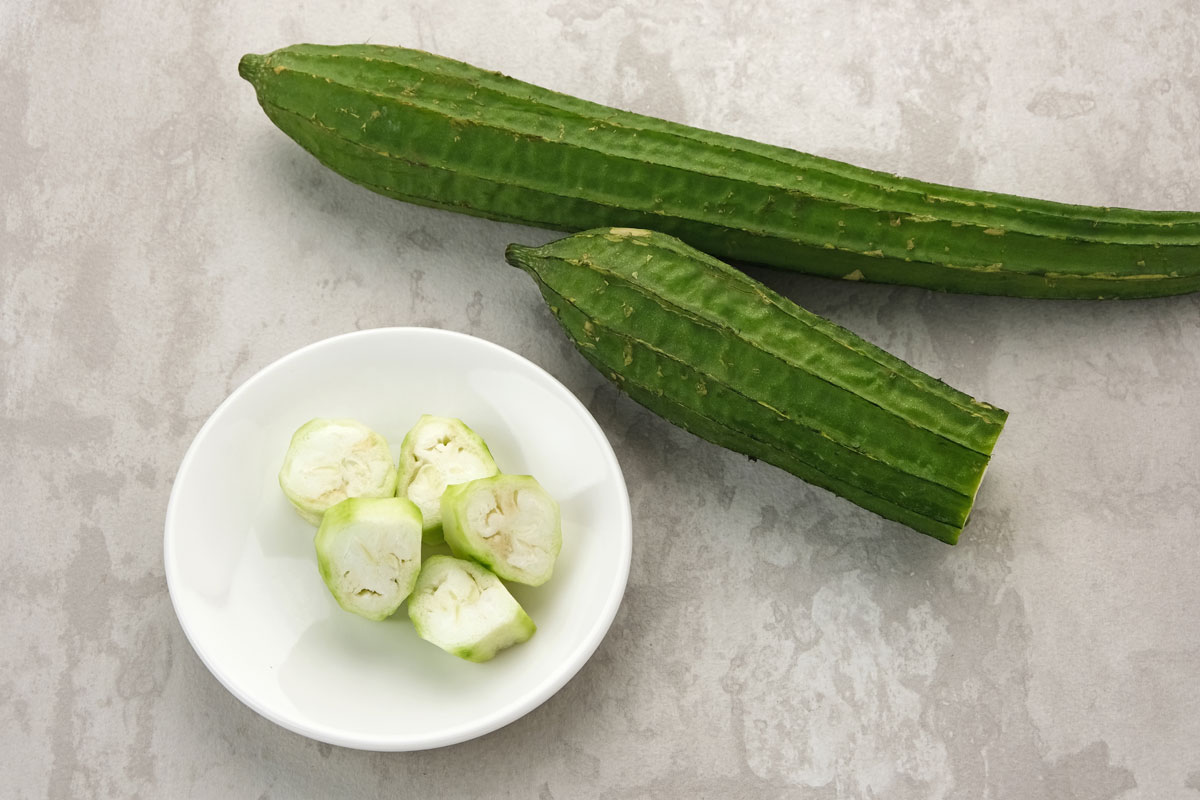
While many people grow luffa for sponges, certain types, like ridged luffa (also known as angled luffa or Chinese okra), are highly prized for culinary use. Ridged luffa has a tender texture and mild flavor, making it a popular vegetable in many Asian cuisines. However, you can also enjoy young, smooth luffa gourds (the same type used for sponges) when they are harvested early before the fibers begin to develop.
I haven’t eaten luffa yet—I’ve been holding onto every gourd to make sponges! But I’ve done some research on how to prepare them for tasty meals and found a few delicious recipes I’ll share later in this article. Now that I’ve built up a good stash of sponges, I’m planning to try growing ridged luffa next. I didn’t want to grow both varieties in the same year, though, to avoid cross-pollination since I save my seeds.
How to Tell When Your Luffa is Ready to Eat:
- Check the size: For ridged luffa, harvest when the gourd is 6–12 inches long and still tender. Young sponge luffa should be picked even smaller, around 4–6 inches, while the skin is smooth and the gourd feels firm but not hard.
- Observe the skin texture: The skin should be bright green, glossy, and free of blemishes or tough spots. Avoid gourds that feel woody or have started to yellow, as this indicates the fibers are developing.
- Use your sense of touch: Gently squeeze the gourd. It should have a bit of give, indicating it’s still tender inside. A hard, rigid feel means it’s too mature for eating.
Tips for Harvesting Edible Luffa:
- Use sharp garden shears to snip the gourd from the vine, leaving a small stem attached to reduce moisture loss.
- Harvest regularly to encourage continuous production throughout the growing season.
- Store freshly harvested luffa in the refrigerator if you’re not using it right away, but enjoy it within a few days for the best flavor and texture.
Tender, young luffa is versatile in the kitchen—perfect for stir-fries, soups, and curries. Its mild flavor absorbs seasonings well, and its soft texture adds a delicate touch to your favorite dishes.
Recipes I found you may enjoy:
- Stir-Fried Luffa with Eggs Chinese Recipe
- Loofah Stir-Fry with Chicken
- Sauteed Luffa Gourds with Grated Parmesan
Using Luffa as Natural Sponges
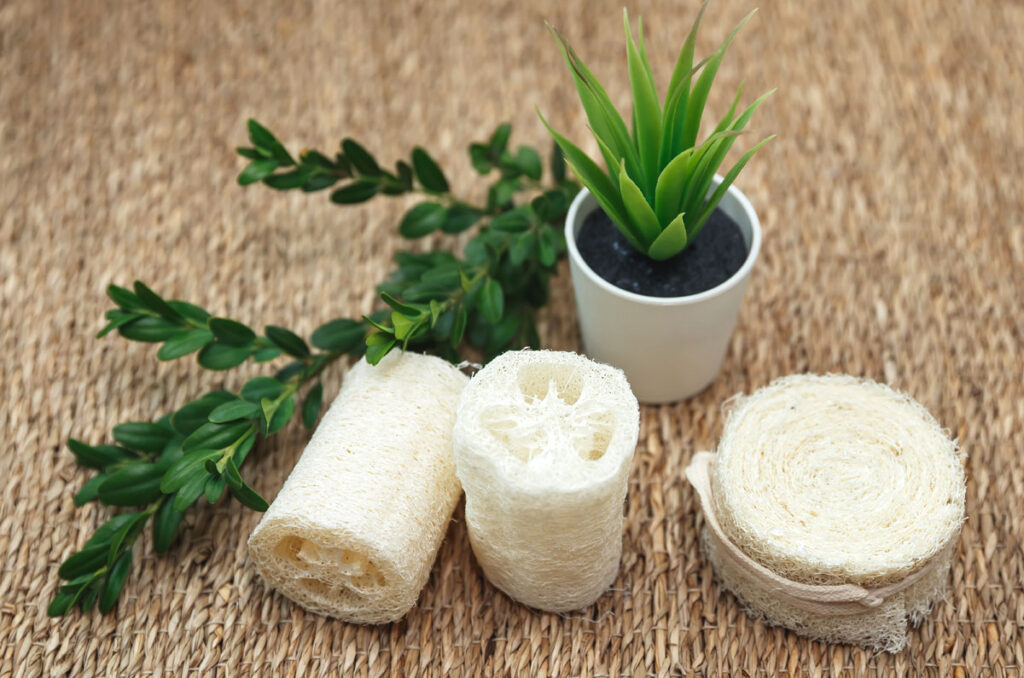
Ever since I started growing luffa, I’ve been discovering new ways to use them. They’re a frugal, eco-friendly solution for everyday household needs that have quickly become a regular part of my life. Here are some creative ways to put them to work as natural sponges once you’ve harvested, cleaned, and dried your gourds.
Bath and Body
Luffa sponges are perfect for exfoliating your skin. Simply cut the dried gourd into desired lengths, soak it to soften, and use it with your favorite soap or body wash. Keep a small basket of them under your bathroom sink for easy access, or tie a water-resistant rope through a luffa gourd and hang it in your shower for convenient use.
Household Cleaning
Luffa makes an excellent, gentle scrubber for dishes, countertops, or even garden tools. They’re durable yet gentle enough for most household surfaces. I keep a container under my kitchen sink and use it almost daily for cleaning.
Vegetable Scrubber
Use luffa to scrub potatoes, carrots, sweet potatoes, and other garden produce. They last a long time, and when they’re worn out, you can simply compost them—no waste!
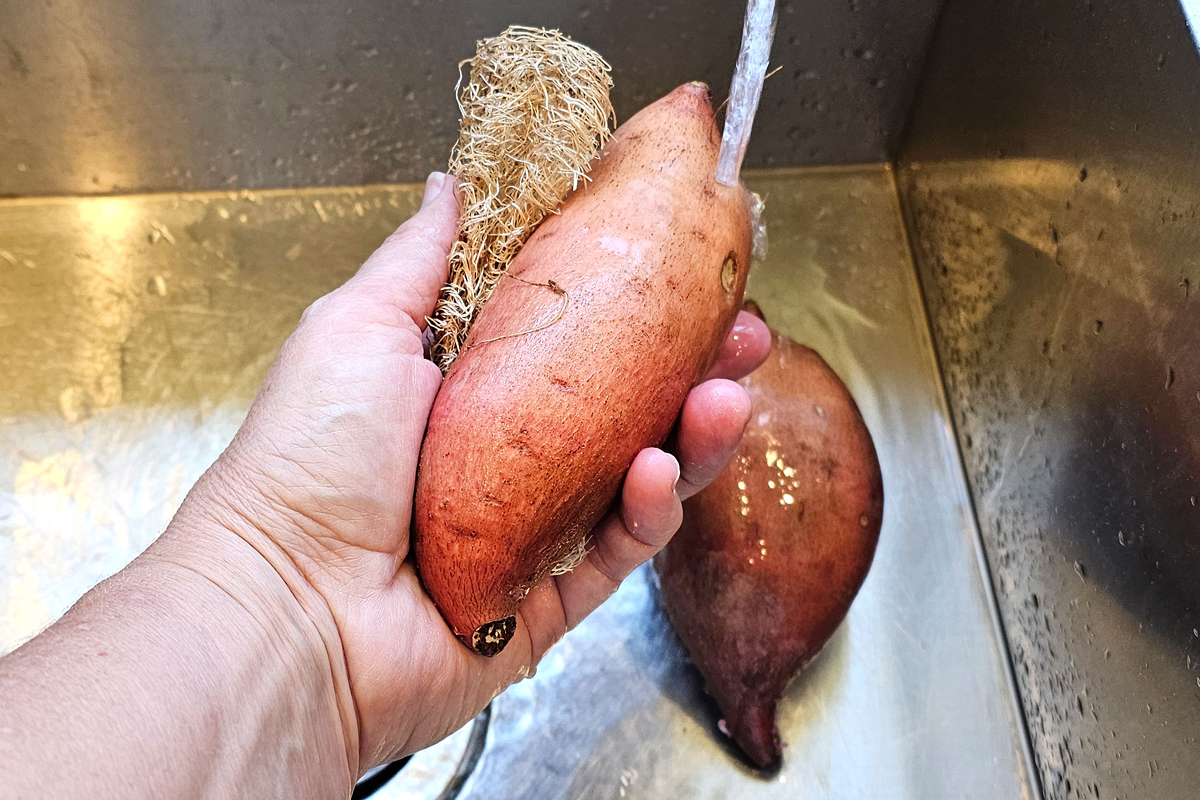
Pots and Pans Scrubber
Luffa is a great alternative to stainless steel scrubbers for cleaning pots and pans. They’re perfect for scrubbing cast iron (just soak the pan and scrub away) and gentle enough for non-stick cookware, making them a versatile option in the kitchen.
Heavy-Duty Hand Cleaner
After a tough day of work, luffa sponges make a fantastic tool for cleaning up grimy hands. My husband uses them to get rid of grease and dirt—they’re tough on grime but gentle on the skin.
Using Luffa for Craft Projects
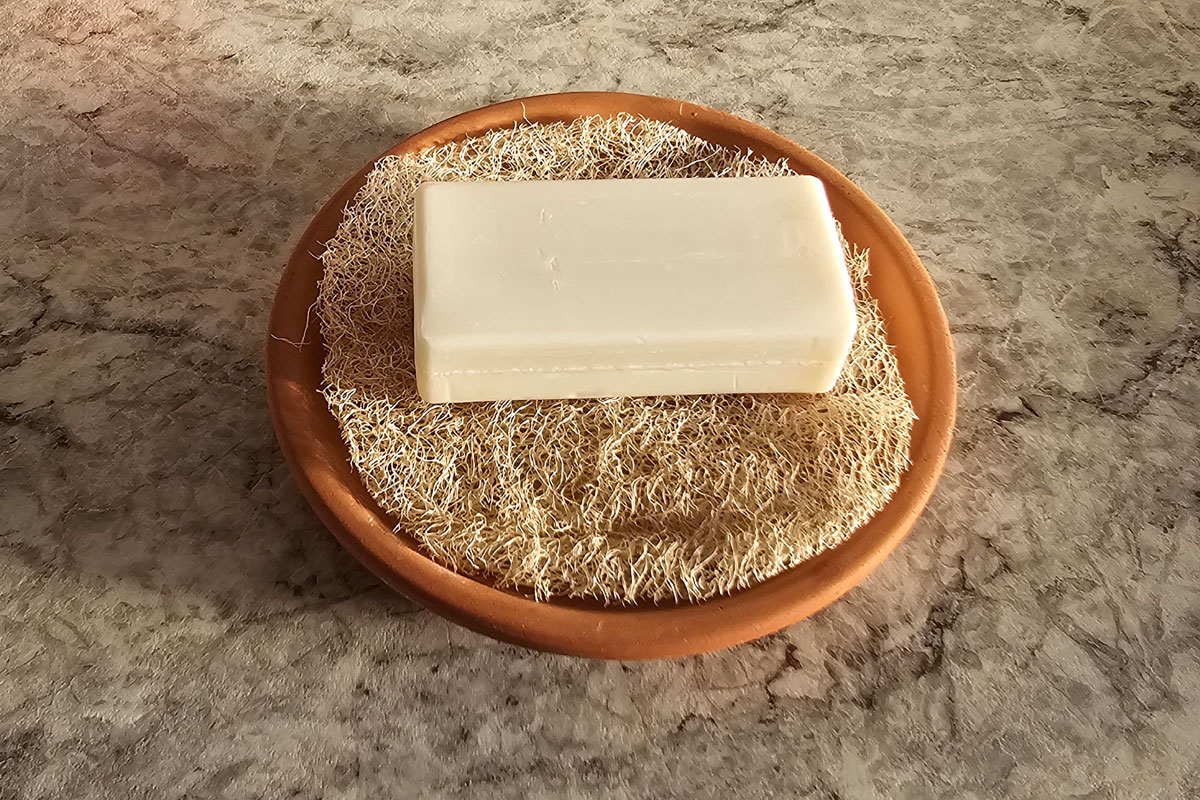
If you’re looking for frugal, eco-friendly craft ideas, luffa is a great choice! Not only is it a versatile material for many household uses, but it’s also a great way to repurpose something grown right on your homestead. Whether you’re crafting bath accessories, natural décor, or even plant care solutions, luffa is an affordable and sustainable choice. Here are a few creative projects that let you make the most of this budget-friendly plant!
Handmade Soap Scrubbers
One of the most popular ways to use luffa is by embedding slices of it into bars of homemade soap. The luffa acts as a natural scrubber, perfect for exfoliating your skin while you wash. Simply cut the luffa into thin slices and press them into the soap mixture before it hardens. The result? A beautifully textured soap bar that makes bath time feel like a spa experience!
Luffa Bath Mitts
For a more customizable bath experience, create your own luffa bath mitt! Sew luffa slices together to form a soft, exfoliating mitt. When it’s time for a relaxing soak, you can use the mitt to gently scrub your skin, leaving it soft and refreshed. This project also makes for thoughtful, handmade gifts.
Seed Starting Pots
Instead of buying plastic trays, why not use luffa as a biodegradable option for starting your seeds? Simply cut the luffa into small sections, about 2-3 inches long, and remove any loose fibers from the center to create a natural seed cup. Fill each hollowed-out luffa with seed-starting soil and plant your seeds. Once the seedlings are ready for the garden, you can plant the whole luffa directly into the ground, where it will naturally decompose, leaving behind a healthy, well-established plant.
The best seeds to start in luffa seed pots are those with strong, non-invasive root systems that can grow well in a small space before transplanting. Since luffa fibers create a somewhat loose but structured environment, avoid plants with delicate or easily tangled roots, and avoid root crops which should be direct-sown.
Luffa Wall Hangings and Wreaths
Luffa is perfect for creating rustic décor. Try combining it with dried flowers, vines, or other natural materials to make a stunning wall hanging or wreath. You can experiment with different sizes and shapes to create a custom piece that matches your home’s style. This craft is a great way to bring a little bit of nature indoors.
Luffa Potpourri Bags
Add a touch of fragrance to your home with a simple potpourri bag made from luffa. Slice the luffa into a desired size piece, hollow it out, and fill the inside with your favorite dried flowers, herbs, or spices. The luffa helps to evenly distribute the scent throughout the room while also adding a charming, natural touch to your home décor.
Luffa Garlands
For a festive or rustic touch to decorate your home, string luffa slices together to create a natural garland. This project is perfect for holiday decorations, special events, or even just adding some charm to your everyday space. The earthy look of the luffa works well with dried flowers or even fairy lights for a warm, inviting atmosphere.
Luffa Soap Holders
Instead of using a regular soap dish, try a luffa soap mat. Cut a slice of dried luffa and place it in the bottom of your soap dish. (I prefer using a ceramic dish, or a terracotta plant saucer for a more rustic touch.) The luffa raises the soap, allowing it to drain better and stay dry, which helps extend its lifespan. Plus, it’s easy to clean – just rinse it off and let it dry. This natural solution keeps your soap from sitting in water and offers an eco-friendly alternative to plastic soap dishes.
Luffa Plant Frog
Luffa also makes a wonderful plant frog, which is perfect for holding flower stems in place in a vase. Simply cut a slice of dried luffa and place it at the bottom of the vase. The luffa will help arrange the stems, keeping them steady and giving your floral arrangement a natural, rustic touch. Plus, it’s a biodegradable option that works just as well as traditional metal or ceramic plant frogs.
Bringing It All Together
Luffa gourds are one of the most versatile crops you can grow, offering everything from natural sponges to delicious meals and creative craft projects. Whether you’re harvesting them for scrubbing dishes, making a biodegradable soap mat, or even arranging flowers with a luffa plant frog, these gourds prove just how useful they can be.
By now, you know how to harvest luffa at the right stage—whether for eating or for sponges—how to prepare and store them, and how to use them around your home. Plus, with a little planning, you can even save seeds for next season, ensuring a continuous supply of this frugal and sustainable resource.
If you haven’t tried growing luffa yet, I hope this guide gives you the confidence to give it a go. And if you already grow them, I hope you’ve found a few new ways to use them!
Happy gourd gardening!
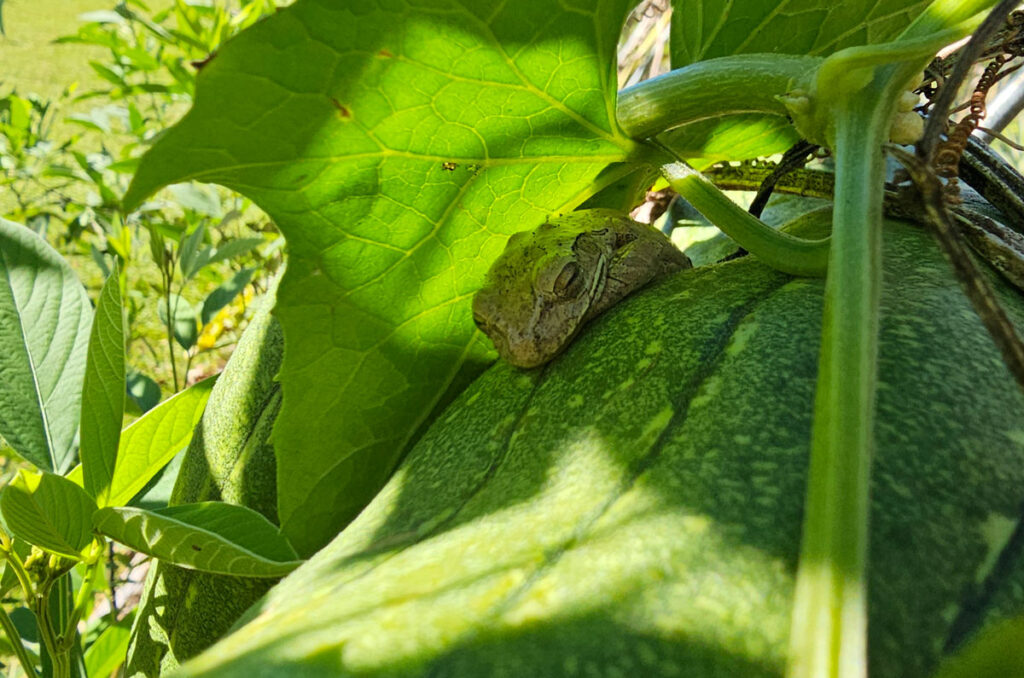
Resources
- 1,2, Seed to Seed by Suzanne Ashworth
- Luffa: Wikipedia
- Luffa – An Asian Vegetable Emerging in Florida
FAQs
With regular use, luffa sponges can last several months before they start to break down. Their lifespan depends on how often they’re used and how well they’re cared for. To extend their use, rinse them thoroughly after each use, squeeze out excess water, and allow them to dry completely in an open, airy space. If they start to develop an odor or feel slimy, it’s time to replace them with a fresh sponge and compost the old one.
Absolutely! Luffa is 100% biodegradable and a great addition to your compost pile. Once your sponge starts to break down, simply cut it into smaller pieces to speed up decomposition. If you don’t compost, you can also bury it directly in your garden, where it will naturally decompose and enrich the soil.
Luffa can cross-pollinate with other luffa varieties, but not with cucumbers, squash, or melons, even though they belong to the same plant family (Cucurbitaceae). If you’re saving seeds and want to ensure a pure variety, it’s best to grow only one type of luffa per season or take extra steps like hand-pollinating flowers and covering them with mesh bags to prevent accidental cross-pollination.
Leave a Reply